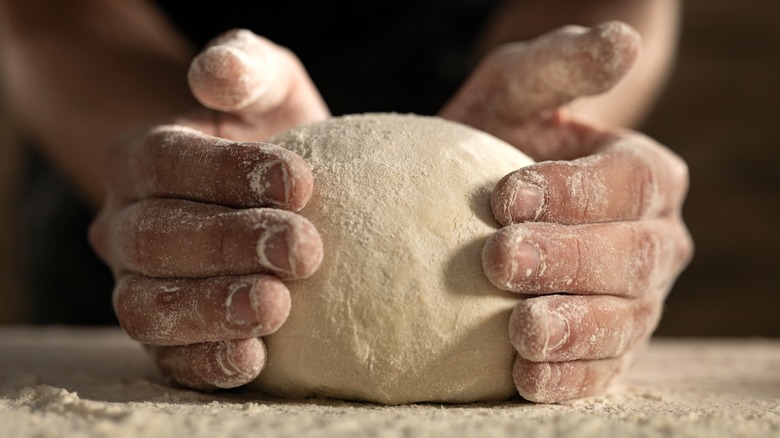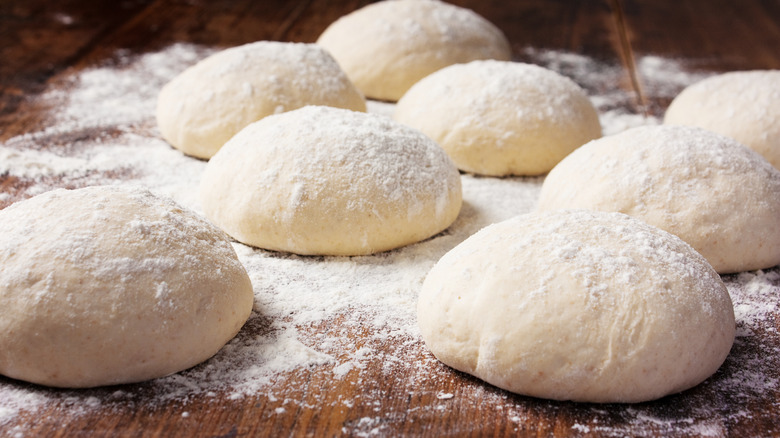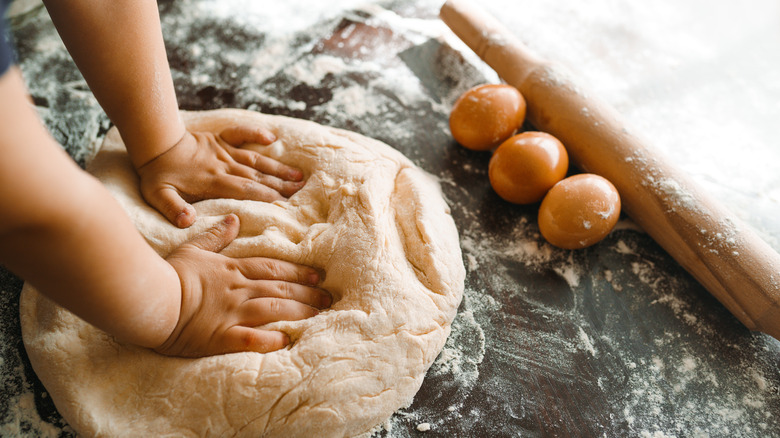The Most Important Rule To Remember When Defrosting Pizza Dough
We may receive a commission on purchases made from links.
Although there's nothing better than ordering a pizza to be delivered right to your door, making your own pizza at home has its own benefits. You can, for example, control what goes on your pizza, make the sauce as sweet, as herby, or as chunky as you'd like, and you can make it deep-dish, thin-crust, round, square, or any shape you want. With most of the basic ingredients already being pre-made, such as the dough, making your own pizza is now a very simple affair.
Of course, just because you find that your homemade pizza dough is already kneaded and shaped doesn't mean that you can just throw some sauce on your dough and toss it in the oven. There are many things you can do — and should do — to ensure that even the cheapest of store-bought doughs taste like they were made fresh in an authentic pizzeria. If you want to give your pizza crust a crispier texture, Mama Cucina suggests that you "par-bake" your pizza dough before adding toppings to help reduce moisture in the dough. If you want to avoid a bland tasteless crust, Pizza Magazine recommends brushing it down with your choice of olive oil, garlic butter, or herb mixture before baking.
Even remembering key steps when you thaw your pizza dough will help give you a much better pizza. But what exactly is so important about thawing your dough the "right way," and what difference does it make?
Make sure the dough stays cool
When you think of defrosting or dethawing something, you probably think about leaving food out until it's near room temperature. Although this works for some things, pizza dough isn't something you want to let sit out on your counter and forget about.
As MasterClass bluntly explains: "The key in the thawing process is to make sure the dough stays cool throughout." If the dough gets too warm, the yeast in the dough will activate and thus "proof" the dough too early. If pizza dough proofs too early and is allowed to sit out for too long, this results in the dough having a gummy, almost chewy texture, and a noticeably "sour" taste (via BakingKneads). By keeping the dough at a sufficiently cool temperature while it defrosts, you can avoid the yeast from proofing too early.
How, then, can you defrost pizza dough quickly without letting it get too warm? A good idea comes from Pizza Oven Reviews, which suggests you "bathe" your dough in cold water. This "cold bath method" has you put the dough, still in its wrapper or bag, in a bowl or container of cold water for one to two hours. This will help the dough to thaw slowly and also prevent it from getting warm too quickly. You can tell the dough is ready by noting the presence of bubbles on the water's surface.
Can pre-proofed dough be saved?
The first time around, you're bound to make mistakes when rolling your own pizza dough. Even if you're incredibly careful, there's a chance that you may wind up with overproofed pizza dough. While you may think this is the end of your pizza dinner, there are a few things you can do to help save it.
According to America's Test Kitchen, a very simple solution to fixing overproofed dough is just to punch it down again. Simply spread the dough out, punch it down gently but firmly with your fingertips, and reshape it the way you want. Let the dough sit again for the suggested amount of time before using it as normal. While the dough may not have the same taste as regular, un-overproofed dough, the end texture should be acceptable.
Modernist Cuisine also refers to this method, describing it as being "Dough CPR." While Modernist Cuisine tells us that this method is good for many types of doughs, pizza included, the end result may have a much paler crust than the golden-brown crust you may have expected. Although overproofed dough may still have a bit of an odd taste or texture, you needn't worry about having to start over from scratch. All it takes is a bit of elbow grease, and you can enjoy a delicious homemade pizza as you normally would. Good things do require a little effort, right?


